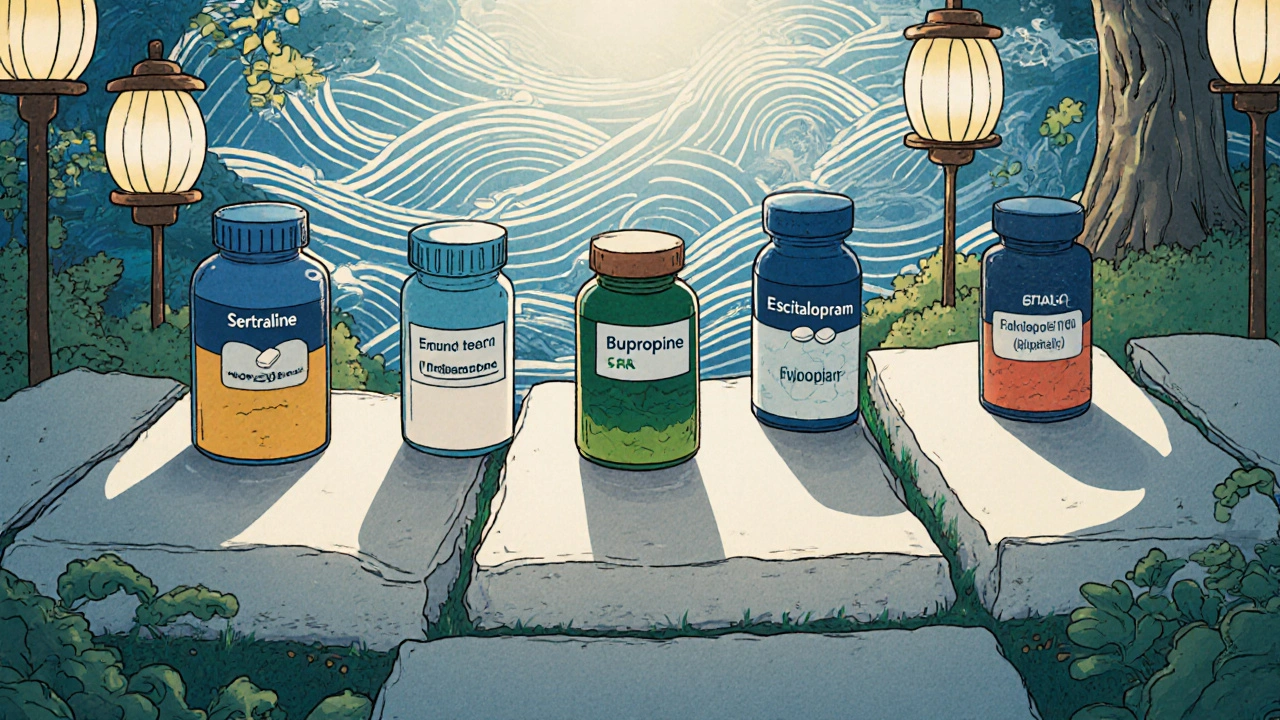
Antidepressant Selection Guide
Find Your Best Match
Answer these questions to get personalized recommendations based on your symptoms and preferences.
Personalized Recommendations
* This tool is for educational purposes only. Always consult your healthcare provider for medical advice.
When you or a loved one need relief from depression, picking the right medication feels like a high‑stakes gamble. Celexa is the brand name for citalopram, an SSRI (selective serotonin reuptake inhibitor) that’s been prescribed for over two decades. But it isn’t the only player on the market. Below we break down how Celexa stacks up against the most common alternatives, so you can see the trade‑offs in plain English, not pharma‑speak.
What makes Celexa tick?
Celexa works by blocking the serotonin transporter, allowing more serotonin to stay in the synaptic gap. The result is a smoother mood curve for many patients. Its typical dose starts at 20 mg once daily, with a maximum of 40 mg. The drug’s half‑life sits around 35 hours, meaning steady blood levels can be reached in about a week. Common side effects include nausea, dry mouth, and occasional sexual dysfunction. Because it’s an SSRI, you’ll also see a warning about a possible increase in suicidal thoughts during the first few weeks, especially for people under 25.
Top alternatives at a glance
Below are the most frequently prescribed antidepressants that clinicians compare to Celexa. Each has its own mechanism, dosing quirks, and side‑effect profile.
- Sertraline - another SSRI marketed as Zoloft; favoured for its low drug‑interaction risk.
- Escitalopram - the S‑enantiomer of citalopram, sold as Lexapro; often praised for fewer gastrointestinal complaints.
- Fluoxetine - known as Prozac; has a very long half‑life, useful for patients who miss doses.
- Bupropion - a norepinephrine‑dopamine reuptake inhibitor (NDRI) sold as Wellbutrin; can boost energy but may raise seizure risk.
- Mirtazapine - a noradrenergic and specific serotonergic antidepressant (NaSSA) marketed as Remeron; excellent for patients who struggle with insomnia.
- SNRIs - a class that includes venlafaxine and duloxetine; target both serotonin and norepinephrine pathways.

Side‑by‑side comparison
| Attribute | Celexa (Citalopram) | Sertraline (Zoloft) | Escitalopram (Lexapro) | Fluoxetine (Prozac) | Bupropion (Wellbutrin) | Mirtazapine (Remeron) |
|---|---|---|---|---|---|---|
| Class | SSRI | SSRI | SSRI | SSRI | NDRI | NaSSA |
| Typical Starting Dose | 20 mg daily | 50 mg daily | 10 mg daily | 20 mg daily | 150 mg daily | 15 mg daily |
| Half‑Life | ≈35 h | ≈26 h | ≈27 h | ≈4-6 days | ≈21 h | ≈30 h |
| Common Side Effects | Nausea, dry mouth, sexual dysfunction | Diarrhea, insomnia, sexual dysfunction | Less GI upset, mild sexual issues | Insomnia, agitation, weight loss | Insomnia, dry mouth, tremor | Weight gain, sedation, increased appetite |
| Weight Impact | Neutral to slight loss | Neutral | Neutral | Possible loss | Weight neutral or loss | Weight gain |
| Cost (UK NHS price, 2025) | £4.20 / 28 tablets | £5.10 / 28 tablets | £5.80 / 28 tablets | £4.50 / 28 tablets | £6.00 / 28 tablets | £5.60 / 28 tablets |
| Key Advantages | Well‑studied, simple dosing | Low interaction profile | Fewer GI side effects | Long half‑life, less withdrawal | Boosts energy, no sexual side effects | Excellent for sleep, appetite stimulation |
| Typical Use Cases | Major depressive disorder, anxiety | Depression, PTSD, OCD | Depression, generalized anxiety | Depression, bulimia, PMDD | Depression, smoking cessation | Depression with insomnia or weight loss needs |
How to decide which antidepressant fits you
Choosing a medication isn’t a one‑size‑fits‑all decision. Here’s a quick cheat‑sheet you can run through with your prescriber.
- Symptom profile: If fatigue and low appetite dominate, a medication like Mirtazapine can help. If you’re battling low energy and you don’t want sexual side effects, Bupropion may be a better match.
- Drug interactions: Patients on multiple meds often gravitate to Sertraline because it has a relatively clean interaction profile.
- Adherence concerns: A long half‑life drug like Fluoxetine is forgiving if you miss a dose.
- Cost & NHS availability: In the UK, most of these options are on the NHS formulary, but price differences can affect private prescriptions.
- Side‑effect tolerance: If weight gain worries you, steer clear of Mirtazapine. If sexual dysfunction is a deal‑breaker, discuss Escitalopram or Bupropion first.
Never change or stop a medication without medical guidance. Tapering schedules differ between SSRIs and SNRIs, and abrupt cessation can cause discontinuation syndrome.

Managing side effects and maximizing benefit
Even the perfect drug can feel rough at first. Here are practical steps that help most patients.
- Take the pill with food if you get nausea - most SSRIs are better tolerated that way.
- Stay hydrated; dry mouth usually eases after a week.
- Schedule a check‑in with your doctor after 4-6 weeks to assess efficacy and adjust dose.
- If sexual side effects persist, ask about dose timing (morning vs night) or a brief drug holiday under supervision.
- For insomnia, consider a low‑dose Mirtazapine at bedtime, or add a non‑prescription melatonin.
Frequently Asked Questions
Is Celexa more effective than other SSRIs?
Effectiveness varies per individual. Clinical trials show Celexa works about as well as sertraline and escitalopram for moderate depression, but personal response and side‑effect tolerance often decide the winner.
Can I switch from Celexa to another antidepressant safely?
Yes, but you’ll need a tapering plan. Most doctors cross‑taper Celexa down while introducing the new drug at a low dose, usually over 1-2 weeks, to avoid withdrawal symptoms.
What should I do if I miss a dose of Celexa?
Take the missed tablet as soon as you remember unless it’s close to the next scheduled dose. In that case, skip the missed one and continue with your regular timing - don’t double up.
Are there any foods or drinks I should avoid?
Avoid excessive alcohol, as it can increase sedation and worsen depression. Grapefruit juice can affect the metabolism of many SSRIs, though the impact on citalopram is modest.
How long before I notice improvement?
Most patients feel a subtle lift after 2-4 weeks, with full therapeutic effect emerging around 6-8 weeks. Patience is key; stopping early can reset progress.

5 Comments
Picture this: you’re navigating a maze of meds, each promising a sunrise but delivering a haze.
Celexa, the old‑timer citalopram, often feels like that reliable compass your granddad swore by.
Its half‑life of roughly 35 hours means the bloodstream gets a steady drizzle rather than a tidal wave.
That gentle rhythm can be a boon for folks who hate the roller‑coaster spikes of some SSRIs.
Side‑effects? Think of nausea and dry mouth as the occasional potholes on an otherwise smooth road.
Sexual dysfunction crops up for some, a reminder that neurotransmitters love to meddle with desire.
When you compare it to Zoloft, the drug‑interaction profile of Celexa is a shade less tangled.
Escitalopram, its S‑enantiomer sibling, shaves off a touch of gastrointestinal turmoil.
Fluoxetine’s marathon‑length half‑life makes it forgiving, yet the flip side is lingering withdrawal whispers.
Bupropion flips the script entirely, revving up dopamine and norepinephrine for that extra spark.
Mirtazapine, meanwhile, trades alertness for a plush pillow‑like sedation, perfect for night‑owls battling insomnia.
In the cost arena, Celexa’s £4.20 per blister rivals most rivals, keeping wallets from screaming.
If weight gain is your nemesis, steer clear of Remeron; Celexa stays pretty neutral on the scale.
Conversely, if you’re racing toward a slimmer silhouette, Prozac’s appetite‑suppressing side might catch your eye.
Ultimately, the ‘right’ pick hinges on your unique symptom tapestry, co‑morbidities, and how your liver likes to metabolize.
So sit down with your prescriber, map out these trade‑offs, and let the science‑backed dialogue steer you toward a steadier horizon.
Wake up, they’re hiding the truth about pharma’s mind‑control agenda behind fancy brand names!
Thanks for breaking it down in such vivid detail, that really helped me see the bigger picture.
One thing I’d add is that the timing of the first noticeable lift can differ; some folks feel a whisper of improvement within two weeks, while others need the full six‑to‑eight week runway.
Don’t forget to keep an eye on any emergent anxiety or restlessness, especially early on, and flag those to your clinician.
Pairing the medication with a regular sleep schedule, light exposure, and a dash of gentle exercise often amplifies the benefit.
Lastly, remember it’s okay to ask for a dose tweak or a switch if the side‑effects start feeling like a storm rather than a drizzle.
Medications are essentially tools, and like any tool they’re only as good as the hand that wields them.
The brain’s chemistry is an intricate tapestry, and pulling one thread can ripple across the whole design.
Celexa offers a subtle nudge, whereas drugs like Bupropion give you a jolt of energy, each fitting different life narratives.
Choosing one is less about finding a magic bullet and more about aligning the drug’s profile with your personal rhythm.
Think of it as matching a soundtrack to a movie scene; the right score can elevate the experience, the wrong one can clash.
In practice, the process is iterative-start low, monitor, and adjust, always in conversation with a trusted clinician.
Your analogy is apt, yet it is essential to acknowledge that a systematic approach, including regular assessment scales, mitigates the risk of misalignment between drug action and patient expectation.
Patients should be encouraged to report even minor adverse events promptly; early intervention prevents escalation.
Moreover, clinicians must not hesitate to cross‑taper when necessary, as abrupt discontinuation can precipitate severe discontinuation syndrome.